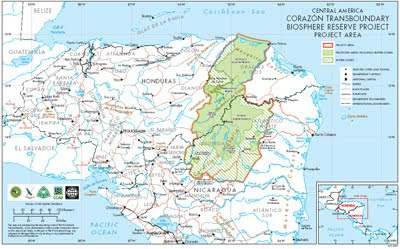Please set aside some time to watch this fantastic video about the destruction being done in the "protected" Río Plátano Biosphere Reserve. The video is about 30 minutes long and well worth the time spent as you'll be seeing a part of the world that not many have seen.

Río Platano
Photo: Friends of Río Platano Biosphere Reserve
Photo: Friends of Río Platano Biosphere Reserve
The reserve was declared a World Heritage Site by the United Nations in 1982. It includes approximately 5,250 sq. km. (1,300,000 acres) of mountainous and lowland tropical rainforest, where 39 species of mammals, nearly 500 species of birds and 126 reptiles and amphibians have been recorded. Threatened species include giant anteater, Baird's (Central American) tapir, jaguar, ocelot, puma, Central American otter, Caribbean manatee, among others.
 In 1996, the UN declared the reserve to be in danger. It was removed from the endangered list in 2007 due to "significant progress", but was placed back on the list again in June 2011 at the request of the government of Honduras due to the combined threats of illegal logging, fishing and land occupation, poaching and the government's reduced capacity to manage the site, notably due to the deterioration of law and to the presence of drug traffickers. As this video shows, much damage is being done in the protected area.
In 1996, the UN declared the reserve to be in danger. It was removed from the endangered list in 2007 due to "significant progress", but was placed back on the list again in June 2011 at the request of the government of Honduras due to the combined threats of illegal logging, fishing and land occupation, poaching and the government's reduced capacity to manage the site, notably due to the deterioration of law and to the presence of drug traffickers. As this video shows, much damage is being done in the protected area.But a friend of mine says that the narcos aren't the real problem — except that they scare the authorities away — because they like things all jungly where they can hide their mansions and hummers among the foliage. A bigger problem is the farmers and cattle ranchers who cut down all the trees to grow corn or pasture the cows, and the hunters who kill the animals and dynamite the river to kill the fish.
I'd love to tell you a little story about an adventure in the jungle but I'm afraid that it might put my friend in danger.
According to the UNESCO World Heritage website, the site of Ciudad Blanca (White City) within the protected area constitutes one of the most important archaeological sites of Mayan civilization. Archaeological remains include the Piedras Pintadas petroglyphs on the bed of the Plátano River, believed to belong to an unknown pre-Columbian culture.
Find out more about the Río Plátano Biosphere at the UNESCO website or Wikipedia. Join the Friends of the Río Plátano Biosphere Reserve cause on Facebook.
Or if you are a real adventurer, see it for yourself through a tour with Jorge Salaverri of La Moskitia Ecoaventuras, the guide in this video.
Note: The link to La Moskitia Ecoaventuras has been updated to a more complete website.


 Welcome to my Blogicito —
Welcome to my Blogicito — 







